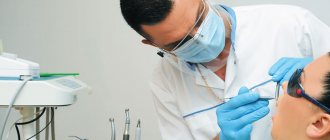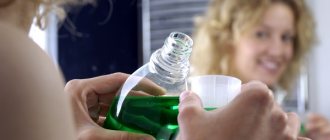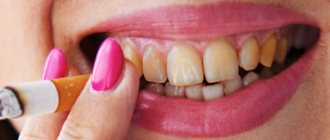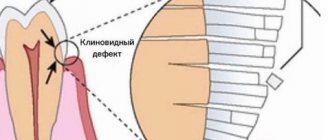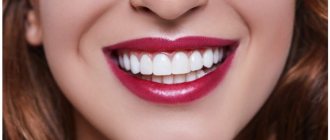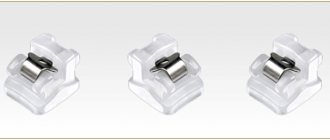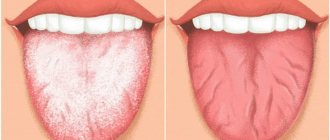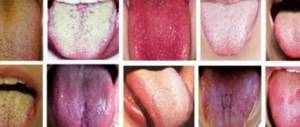That's why even minor symptomatic manifestations in a baby can become a serious cause for concern.
A yellow coating on the tongue of a baby is a common phenomenon, indicating both diseases of the gastrointestinal tract or disturbances in the functioning of internal organs, and the need to replace a formula that is not suitable for the baby.
Note! In order not to worry about the baby’s health, it is worth taking a closer look at the causes of the symptom.
Why might a yellow coating appear on a child’s tongue?
Healthy children have a translucent coating on the tongue of a loose structure. If there is a change in color or density, you should consult a specialist, because the reasons can be quite serious.
More often, the tongue indicates problems in the digestive system
Parents should be alert to the following symptoms:
- maintaining yellowness on the tongue for a long time;
- changes in plaque parameters (increase in color intensity, size of the affected area, layer thickness);
- unpleasant odor from the mouth.
More often, the tongue indicates problems in the digestive system.
Characteristic manifestations can be supplemented by poor appetite, nausea, vomiting, as well as pain in the abdominal area.
When visiting a clinic, the doctor considers the presence of yellowness as one of the symptoms of the following diseases:
- jaundice (physiological in infants, hemolytic, hepatitis);
- poisoning;
- inflammations in the oral cavity of various types (stomatitis, caries, sore throat, gingivitis, glossitis);
- infectious diseases in which there is an increase in temperature;
- severe somatic pathology (diabetes, autoimmune processes, kidney disorders, etc.).
If yellowness is detected on the surface of the child’s tongue, in addition to consulting a pediatrician, the help of other specialists will be required.
To make an accurate diagnosis, a number of studies are carried out, and only on the basis of the collected tests is the true cause of the formation of yellow plaque on the mucous membrane determined.
Why it appears: reasons
There may be several reasons why a yellow coating appears on the baby’s tongue :
- fungal infection of the oral cavity . Thrush or candidiasis, caused by a fungus of the genus Candida, contributes to the appearance of whitish or yellow deposits that resemble a dense curdled mass;
- autoimmune diseases. They arise as a result of the destruction of the body’s tissues by the body’s own immune system and cause the appearance of many unpleasant symptoms;
- pathologies of the digestive system . Diseases of the stomach and intestines become one of the main reasons for the formation of a yellowish coating on the surface of the baby’s tongue;
- liver diseases . Pathological processes in the bile ducts lead to disruption of the exchange of bile pigment bilirubin, which causes staining of the tongue and skin;
- diabetes. At the initial stage, endocrine-metabolic disease is characterized by the appearance of a yellowish coating, restless behavior and poor weight gain;
- congenital yellowness of the skin and tongue . This is due to the physiological characteristics of the child’s body. Over time, the problem disappears;
- infectious diseases of the ENT organs. A sharp increase in body temperature causes cracking of the tongue and bleeding from small capillaries, which provokes the appearance of plaque;
- low-quality formula for feeding a newborn. Often affects the formation of white or yellow plaque and accompanies the little patient until the parents switch the baby to another formula;
- penetration into the child’s body of toxic substances present in the environment. Toxic substances can also enter the digestive system through mother’s milk;
- parasitic diseases . Toxins produced by helminths or giardia have a negative effect on the child’s body, causing the appearance of a dense yellow plaque.
One of the possible and most common reasons for the formation of yellow deposits in infants is the transition from breastfeeding to artificial feeding .
Keep in mind! In this case, the symptom is temporary.
Danger
There is no need to worry when your tongue turns yellow in the following cases:
- Parents should be alerted to plaque that does not go away for a long time
when staining the mucous membranes and tissues in the oral cavity after consuming products with a coloring effect;
- if oral hygiene is not maintained;
- overeating food, in particular saturated fat;
- after taking medications.
This yellowness disappears after several procedures of cleaning the teeth and the mucous membrane with a special brush.
Parents should be alerted to plaque that does not go away for a long time, especially if other symptoms characteristic of the disease also appear.
This may be increased body temperature, nausea, gag reflex, frequent attacks of heartburn, decreased appetite, and abdominal pain. In this case, it is worth paying attention to the structure of the layer and its shade.
A thick, dense coating with a large localization zone and a green or dark brown tint does not bode well.
When examining the tongue, you can pay attention to the localization of the plaque.
Each place signals disturbances in the functioning of certain organs:
- if yellowness is concentrated on the back of the tongue, there is reason to suspect problems with the intestines;
- a yellow tip indicates a heart problem;
- an uneven plaque with cracks forms on the midline due to gastritis and ulcers;
- the extreme posterior points on the tongue indicate kidney dysfunction;
- coating of the front part and along the edges indicates diseases of the respiratory system;
- when diagnosing the spleen, yellowness is noted on the right, and liver problems are read on the left side;
- plaque over the entire surface with uneven coverage is a signal of decreased immunity.
Features of consistency and thickness
The norm is a thin layer of plaque , through which the papillae and pink color of the surface of the tongue are clearly visible.
At the same time,
the appearance of bad breath is unacceptable .
In the absence of disease, plaque should be cleaned well with a toothbrush.
Otherwise, one should assume serious disturbances in the condition of the body.
Especially in the case of a dense, thick layer of yellow plaque , which is formed again every time after cleaning the oral cavity)
Most common reasons
Let's look at the most common reasons for the appearance of a yellow coating on a child's tongue:
| Yellowness on a child 's tongue | ||
| Cause | Symptoms | Treatment |
| Overeating the night before | Unpleasant sensations in the stomach, heaviness, nausea, dry mouth, yellowish coating on the tongue | A gentle diet, drinking and rest are prescribed. In case of constipation, an enema is recommended. |
| Inflammatory process of the oral cavity | Plaques on the tonsils, formation of aphthae, ulcers. A pronounced yellow coating is localized at the tip of the tongue and in the middle. | Anti-inflammatory drugs are prescribed to eliminate the cause. The plaque goes away as the child recovers with the help of daily oral hygiene. |
| Infectious diseases | High body temperature, vomiting, diarrhea, bleeding cracks in the tongue and yellow-brown coating | First of all, the cause of yellowness in the tongue is eliminated. To remove plaque, it is recommended to follow generally accepted rules of hygiene: brushing your teeth and oral mucosa twice a day, rinsing the cavity after each meal. |
| Jaundice | Yellowing is observed not only on the mucous membrane, but also on the skin and whites of the eyes. In addition, weakness, lethargy, and pain in the right hypochondrium are noted. The coating forms on the mucous membrane of the tip of the tongue and its frenulum, the shade is close to lemon. | A blood test and liver biopsy are performed to determine the exact cause of the disease. Drug treatment is prescribed individually, taking into account the nature of the origin of the disease. The drugs used are: Silibor, Sirepar, Silibinin, etc. Phototherapy is also carried out, and a diet is recommended. When an obstructive form is diagnosed, surgery is prescribed. |
| Gastrointestinal disorders | Symptoms: loss of appetite, nausea, vomiting, pain in the duodenum, heartburn, bad breath. Light yellowness (white-yellow or gray-yellow coating), located in the central part of the tongue. | Conducting drug treatment using drugs: Chamomill, Dioscorea, Magnesia phosphorica, Colocynth, etc. In addition to drugs, a diet rich in minerals and vitamins is developed, and a food intake regimen is established. |
| Insufficient oral hygiene | Yellowness on the tongue, teeth and gums, plaque has a dense structure. | Daily brushing of teeth and the surface of the tongue with toothpaste using a scraper and brush, which is intended for mucous membranes. Mouth rinsing is recommended after every meal. |
| Somatic pathologies | There is intoxication, disruption of the body's metabolic functions and other symptoms characteristic of a particular disease. The tongue is covered with a yellow coating with a slightly brownish tint, localized in a dense layer over almost the entire surface of the tongue. | Patients are prescribed a medicinal course of treatment, which is supplemented by psychotherapeutic influence to regulate the mechanism of development of the disease. A diet is also being developed to strengthen the body’s immune system and saturate it with vitamins. |
Possible causes of a yellow coating on a child’s tongue
The most extensive group of infectious diseases that are characteristic of childhood is considered:
- diphtheria;
- scarlet fever;
- foot and mouth disease;
- whooping cough;
- cholera;
- dysentery, etc.
Yellowing of the oral mucosa can have a different origin; it is not possible to determine the exact cause at home, unless, of course, it is the consumption of food with a coloring effect.
You can assess the situation and prescribe treatment only by understanding why the plaque appeared, after taking tests and performing an ultrasound.
Plaque due to gallbladder or liver disease
The cause of yellowness with a greenish tint in such cases is a significant increase in the concentration of bilirubin pigment in the blood and bile due to the following diseases:
- Viral hepatitis of all types. It also causes the skin and sclera of the eyes to turn yellow.
- Liver cirrhosis or liver failure. The plaque acquires a grayish-yellow tint, and nausea, vomiting, and low blood pressure may appear.
- Various liver poisonings from poor quality products or chemicals.
- Overload of the liver as a result of overeating, regular excess consumption of fatty, fried or smoked foods.
- Inflammation of the ducts that remove bile and the gallbladder itself.
Plaque due to gastrointestinal diseases
- Stomach ulcer or gastritis - symptoms of such diseases, along with an intense yellow coating, are heartburn, bitterness in the mouth, abdominal pain, nausea.
- Inflammation of the pancreas and pancreatitis. My stomach also hurts and I feel nauseous.
- Various intestinal colitis - also accompanied by diarrhea, pain in the lower abdomen and in the navel area, the appearance of blood or mucus in the stool.
- Intestinal infections of various types - salmonellosis, dysentery, food poisoning, staphylococcus. Usually accompanied by dehydration due to vomiting or diarrhea. The yellow coating becomes very dense and dry.
Plaque due to somatic pathologies
Yellow plaque may appear as a result of the following severe somatic diseases:
- Diabetes.
- Kidney diseases.
Diagnostics
If a child has noticed a change in the color of the mucous membrane on the tongue, it is necessary to first exclude everyday incidents that led to this effect.
If a child has noticed a change in the color of the mucous membrane on the tongue, it is necessary to first exclude everyday incidents that led to such an effect.
It is impossible to eliminate dangerous situations on your own, so it is recommended to contact your local pediatrician.
After the examination, you may need to consult a dentist or gastroenterologist.
If severe somatic pathologies are detected, the child is referred to a specialized specialist (endocrinologist, hepatologist, nephrologist, hematologist).
To confirm or refute a preliminary diagnosis, it is necessary to conduct a number of studies:
- blood, stool and urine tests;
- a detailed biochemical blood test (for the level of glucose, bilirubin, ALT, AST, creatinine, urea, etc.);
- Ultrasound of organs involved in the functioning of the digestive system, and, if necessary, the abdominal cavity;
- esophagogastroduodenoscopy.
Vegetables and fruits that are yellow can cause your tongue to turn yellow.
Methods of treatment and prevention
Oral hygiene is an important factor. The same habits and remedies that help treat yellow tongue also help prevent it. Common methods of treatment and prevention of yellow tongue:
- brush your teeth thoroughly;
- rinse your mouth after eating;
- clean your tongue with a soft brush;
- use a fluoride rinse;
- scrape your tongue every day;
- rinse your mouth for 60 seconds (a solution of 1 part hydrogen peroxide to 5 parts water);
- quit smoking and not use tobacco products;
- treatment of sinusitis;
- treatment of oral diseases;
- use a humidifier to reduce dry mouth;
- use decongestant nasal sprays;
- reduce consumption of sweets;
- increase fiber intake;
- limit consumption of foods rich in starches or carbohydrates;
- avoid sugary drinks, alcohol and caffeine;
- eat healthy foods with enough fiber;
- avoid colored or colored drinks;
- avoid hot or sour drinks and foods;
- treatment of infections;
- avoid using recreational drugs;
- consumption of probiotics and fermented milk products.
In cases where a yellow tongue causes pain, burning or discomfort, your doctor may prescribe medications. Doctors prescribe medications only when symptoms are severe or when the condition has a specific cause, such as a geographic tongue.
Drugs that can be used for yellow tongue:
- Steroid drugs;
- Salicylic acid mouth rinses;
- Retinoids (vitamin A);
- Antihistamines;
- Antifungal drugs for thrush;
- Creams with 30% urea;
- Antibiotics and antivirals to treat major infections;
- Painkillers.
Treatment
There is no need to treat yellow plaque without eliminating the causes that caused this effect. Therefore, after examination by a doctor (or several specialists), the patient is prescribed medication.
Since most of the causes are associated with disruption of the digestive system, in particular the correct outflow of bile, a series of studies are prescribed, based on the results of which treatment tactics are developed.
Therapeutic therapy is carried out in inpatient and outpatient settings. This issue can only be resolved by a specialist. In addition to medications, a dietary diet is recommended, including lean protein and vegetable foods.
Therapy is often enhanced with phototherapy, sanatorium treatment, and folk methods involving the use of decoctions based on medicinal herbs.
The following components are considered the most effective:
- bee products (propolis, honey);
- a decoction of sage and chamomile for rinsing the mouth;
- eating coarsely chopped vegetables (hard structure removes plaque).
When should you consult a doctor?
Important! Experts recommend not to delay visiting a pediatrician if you have one or more accompanying symptoms that cause discomfort to your baby and negatively affect his mood and general condition.
You should not put off going to the pediatrician in cases where :
- the plaque lasts for five days;
- it is not possible to remove deposits with a brush or bandage;
- the child refuses milk, is capricious and cries for no reason;
- formations appear on the gums and inside of the cheeks.
Preventive measures
Measures to prevent the formation of yellowness on the tongue include the following recommendations:
- Daily oral hygiene will help avoid the appearance of unwanted plaque on the tongue.
Clean your teeth and oral cavity every day with a special scraper;
- Minimize consumption of products containing artificial or natural dyes;
- balance your diet by adding only healthy foods;
- minimize the consumption of carbonated drinks, black tea, coffee (although such drinks are generally not recommended for children);
- do not include smoked and fried dishes in the menu;
- do not overeat while eating;
- Regularly treat dishes and nipples for infants at high temperatures to kill bacteria.
How is it eliminated?
To remove plaque, you must first determine why you or your child has it.
If it is an external factor like smoking, then it is enough to quit the bad habit and the problem will gradually go away. Provided that you take good care of your oral cavity, visit the dentist on time.
When brushing, pay attention to all surfaces in your mouth. Sometimes on the back of the brush there is a ribbed surface designed just for the tongue. Toothpaste should also be used throughout the entire mouth.
Rinsing with decoctions of mint, chamomile, oak bark, and sage helps very well with dental problems.
When these are internal diseases, you need to deal with them first. The cosmetic effect of decoctions, special toothbrushes and pastes will be short-lived.
A healthy lifestyle, no junk food, green tea and juices instead of coffee, and restful sleep can help.
It is dangerous not to pay attention when your or your child’s body gives such a clear signal that it is not feeling well. If you pay attention to this problem earlier, then there is a chance to nip the most serious disease in the bud, rather than having to undergo long and painful treatment later.
After the birth of a baby, a woman tries to surround her child with love and care and monitors the slightest changes in his body. Rash, diaper rash, high fever and poor appetite - all this causes panic among parents. Also a cause for concern is a coating on the child’s tongue. What could be the cause of this disease, why does the yellow plaque appear and how should parents act in this situation?
Different types of yellow plaque
Yellow coating on the tongue of a baby
The discovery of a yellow coating on the tongue of a baby should alert parents. This symptom often indicates a problem in the body. The location of a dense layer on the back part indicates jaundice, and if localized in the left half in the middle, suspicions fall on the liver.
One of the main reasons for discoloration of the oral mucosa of an infant is the accumulation of bacteria. The main number of them accumulates at the root of the tongue.
This localization is explained simply - during feeding, the front part is involved, while the back remains motionless, which eliminates its cleansing. It is easy to prevent the development of bacteriosis by following daily hygiene procedures.
But in any case, it is better to consult a doctor about yellowness so as not to waste precious time.
Signs of newborn jaundice
In a teenager
For a teenager, in addition to the reasons listed, there is another one related to the transition period. The growing up of boys and girls at this stage is accompanied by a hormonal surge. This effect does not have the best effect on the functionality of internal organs.
If the formation and outflow of bile is disrupted, yellowing of the tongue is observed. This symptom does not require treatment; it is enough to manage with hygiene procedures.
Based on the information presented, it should be noted that yellowness on the tongue should at least alert you. You should not rely on chance and wait until the problem disappears on its own. The child’s body is not yet strong enough to cope without the help of specialists.
How to properly remove plaque from a child’s tongue
Thrush is a process of inflammation in the body caused by the fungus Candida.
There is a small safe amount of fungus in every body, but when the immune system decreases, the body ceases to control their formation and then the fungus multiplies and affects the mucous membranes.
Tongue staining from Fanta
There are simple and affordable means to combat thrush:
- After breastfeeding or formula feeding, give the baby a little water to drink each time, which will prevent candidiasis.
- Take a glass of warm boiled water and add one teaspoon of soda, then mix the solution. Then we wet a piece of gauze and gently wipe the baby’s tongue.
- Another effective remedy in the fight against thrush is honey. Mix honey and water at a ratio of 1:2 and wipe the mouth with this solution. But it is worth noting that honey is an allergen, and many babies vomit after eating sweets.
Decoctions for rinsing - chamomile and sage
For this reason, you need to carefully monitor the child’s reaction or use the product for older children.
There are also medications, but before using them, you should consult your pediatrician.
Cleaning a baby's tongue with a special soft brush
It is not recommended to let thrush take its course. As soon as you notice signs of thrush in your baby, treatment should begin. Otherwise, the child’s appetite and well-being may worsen due to the fact that it will be painful for him to eat.

